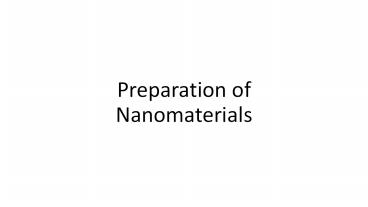Preparation of Nanomaterials - PowerPoint PPT Presentation
Title:
Preparation of Nanomaterials
Description:
This article mainly introduces the preparation of nanomaterials. Visit for more information. – PowerPoint PPT presentation
Number of Views:2269
Title: Preparation of Nanomaterials
1
Preparation of Nanomaterials
2
Introduction
- In 1984, German scientist Gleiter et al.
successfully prepared iron nanoparticles for the
first time by inert gas agglomeration. For
decades, research on the preparation and
application of nanomaterials has yielded fruitful
results. The basic constituent particles of
nanomaterials are of the order of nanometers in
size and are particles in the intersection of
atomic clusters and macroscopic objects. The
diameter of the nanoparticles is generally
between 1 and 100 nm. There are many preparation
methods for nanomaterials, including sol-gel
method, thermal synthesis method, liquid-phase
organic synthesis method, inert gas condensation
method, reverse micelle method, severe plastic
deformation method and the like.
3
Sol-gel method
- The sol-gel method is one of the most important
chemical methods for material preparation. It
provides a new way to synthesize inorganic
ceramics, glass, and nanomaterials at normal
temperature and pressure. The main step of
preparing the nano material by the sol-gel method
is to select the metal compound to be prepared,
then dissolve the metal compound in a suitable
solvent and solidify it by a sol-gel process, and
finally obtain a nanoparticle by low temperature
treatment.
4
Thermal synthesis method
- The preparation of nanomaterials by thermal
synthesis refers to the synthesis of
nanomaterials in an aqueous solution under high
temperature and high pressure, followed by
separation and subsequent treatment to obtain
nanoparticles. Thermal synthesis can produce
products including metals, oxides, and composite
oxides. This method is mainly used in the
preparation of ceramic oxide materials.
5
Liquid-phase organic synthesis method
- The liquid-phase organic synthesis mainly uses
metals, organic compounds and some inorganic
compounds having special properties which are
stable in an organic solvent as a reactive raw
material. These reactants are usually very
sensitive to water and can not be stably present
in aqueous solvents, so the most commonly used
reaction method is to perform reflux in an
organic solvent to prepare nanomaterials.
6
Inert gas condensation method
- The inert gas condensation method is one of the
main methods for preparing nano powders. The main
process of the inert gas condensation method is
to fill low-pressure inert gas in the vacuum
evaporation chamber, and then vaporize the raw
material to form a plasma by vacuum evaporation,
heating, high-frequency induction or the like.
The material gas molecules collide with the inert
gas molecules to lose energy, and agglomerate to
form nano-sized clusters. The inert gas
condensation method has a fast reaction speed, no
other impurities in the process, and the prepared
nano material has high purity. However, this
method has higher requirements for reaction
technology and equipment.
7
Reverse micelle method
- The micro-droplet of reverse micelle in the
water-in-oil microemulsion is a special
nano-space, which can be used as a reaction field
to exchange and react the reactants in different
micelles to prepare nano-scale particles. In the
preparation process, the reverse micelle is a
tiny reaction field and can also be called a
smart microreactor. When using reverse micelles
for nanomaterial preparation, the reactants can
be directly added or blended. Different addition
methods correspond to different reaction
mechanisms, but the results are the same, that
is, highly dispersed and uniform nanoparticles
can be prepared.
8
Severe plastic deformation method
- Severe plastic deformation method means that
under the action of quasi-static pressure, the
material undergoes severe plastic deformation to
refine its size to the nanometer order. The bulk
material is typically refined into a mixture of
crystalline and amorphous materials under
quasi-static pressure and then heat treated to
form nanomaterials. The material prepared by the
method has high purity and good controllability
of particle size.
9
Conclusion
- Nanomaterials have distinct properties that are
different from bulk materials and individual
moleculessmall size effects, surface and
interface effects, quantum size effects, and
macroscopic quantum orbital effects. Due to the
special physical, mechanical, electrical,
magnetic, optical and chemical properties of
nanomaterials, they are of great value in the
fields of electronics, optics, chemistry,
ceramics, biology and medicine. Therefore, it is
foreseeable that nanomaterials will become one of
the pillars of the new round of industrial
revolution in the 21st century.































